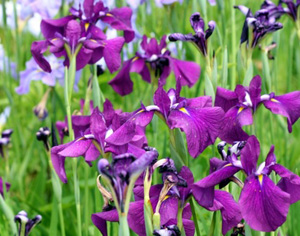
Most iris species require specific growing conditions to thrive. Siberian irises
are no exception. Given proper care, these plants can deliver years of garden value.
Location is an important first step in establishing a successful planting. A
full sun exposure with mid afternoon shade is best for our Central VA growing
season. A good guide to follow for the novice gardener is no less than half-day
sun for optimal spring bloom.
Soil texture is another crucial element in good culture. Siberian irises have a fibrous root system. They prefer a loose and well-drained garden loam. The Piedmont red clay soils can be modified with generous amounts of well-rotted compost and a dash of a coarse grade sand to improve soil structure for roots to spread. Beardless irises like a slightly acidic soil PH. If your garden soil is alkaline, recommended amounts of granular ferrous sulfate, aluminium sulfate or agricultural sulfur will adjust it to a more acidic level. A light application of a complete fertilizer such as 5-10-10 in early spring as new shoots emerge will keep clumps in good health.
Siberians should never be allowed to dry out. Modification with ample amounts of organic matter such as a well-rotted leaf compost help our native soils to retain sufficient moisture to counter our hot and dry Central VA summers. A two inch top dressing of shredded bark, oat straw, pine needles or well shredded leaves provide a reasonable mulch layer to further conserve moisture and discourage weed germination. Mulching with peat moss or grass clippings should be avoided. Our region is prone to periodic summer droughts. Supplemental watering may be needed.
As Siberian irises mature, competition from new rhizomes can result in poor
growth in the center of the clump. Bare root division is necessary. The best
time for this task in Southern gardens is September through early October.
Foliage on the fans to be dug should be cut back one-third to one-half their
original length. This effort balances root loss and provides ease of handling.
A heavy three-pronged digging fork and short handle spade are good tools to pry
out any section of well-established clump. The best multi-fan bare root
divisions to use will come from the outer edge of each excavated section.
Separation may take some work. Once accomplished, each division should have at
least three or no more than twelve rhizomes. They should be immediately placed
in a bucket of water until planting time.
Holes for the new divisions should be wide enough to stretch out roots. The
crown of each piece should be one inch below the soil surface. Pack amended
soil around each division and water. If settling occurs, add more backfill.
Water regularly until plants are established. There are two seasons for planting
Siberian irises. The best choice for Southern gardens is fall installation.
Cooler weather allows bare root divisions to adapt before the next growing season.
Foliage on actively growing clumps should be cut to the ground in late fall as
leaves begin to yellow. Collected debris should be burned or thrown in the garbage.
Siberian irises have some disease and insect pest issues. Iris borer is the
biggest insect concern. Good garden sanitation by cleaning up dead foliage is a
major plus. A good insurance policy is applying a liquid spray of Merit
Insecticide before spring flowering. Use a spreader sticker in the solution to
keep the application on the foliage
Salt marsh caterpillars can cause extensive feeding damage to individual leaves
in mid summer. If larvae are detected, Sevin dust or liquid spray is a good
control measure. Since there may be multiple generations of this pest, additional
treatments may be necessary. Japanese beetle adults can also injure foliage in
the mid summer. Follow label instructions for recommended doses of Sevin or Merit
to address this problem.
Botrytis rot can occur on hybrid Siberian irises in wet springs. New leaves turn
brown and can eventually be pulled away from the base of the fan. Fungal webbing
may be detected at that spot particularly in the early morning hours. Consult your
local Cooperative Extension office for the best advice to combat this disease.
Please remember to consult the product label of any pesticide before making an
application.
Siberian iris can be a great garden asset. Successful yearly care will require
some effort. They are not fool proof, but these marvelous plants can leave a
memorable impression in your home landscape.
